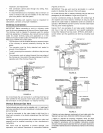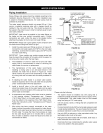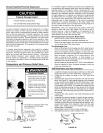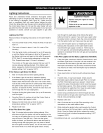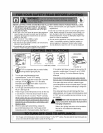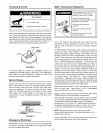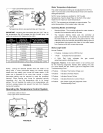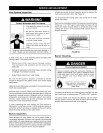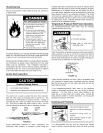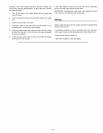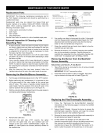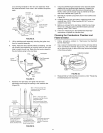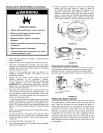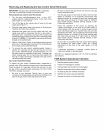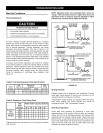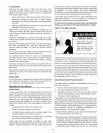
Housekeeping
Vacuum around base of water heater for dust, dirt, and lint on
a regular basis.
Fire and Explosion Hazard
• Do not obstruct combustion air
openings at the bottom of the
water heater.
• Do not use or store flammable
vapor products such as gasoline,
solvents or adhesives in the
same room or area near water
heater or other appliance.
• At least annually, check the
base-ring filter and flame arrester
for any dust, lint, or debris that
may have accumulated. Clean
as necessary.
• Can cause serious injury or death.
AT LEASTANNUALLY, A VISUAL INSPECTION SHOULD BE
MA DE OF THE BA SE-RING FIL TER AND FLA ME ARRES TER.
CLEAN IF LINT ACCUMULATIONS ARE NOTICED.
INSTALLED IN SUITABLEAREA: To ensure sufficient ventilation
and combustion air supply, proper clearances from the water
heater must be maintained. See "Installation Instructions."
Combustible materials such as clothing, cleaning materials, or
flammable liquids, etc. must not be placed against or adjacent
to the water heater because they could catch on fire.
Anode Rod Inspection
Property Damage Hazard
• Avoid water heater damage.
• Inspection and replacement of anode rod required.
indicates high water conductivity and should be checked and/or
replaced more often than an anode rod that appears to be intact.
Replacement of a depleted anode rod can extend the life of
your water heater. Inspection should be conducted by calling the
Sears Service Center for an authorized contractor. The anode
rod should be inspected after a maximum of three years and
annually thereafter until the condition of the anode rod dictates
its replacement. NOTE: artificially softened water requires the
anode rod to be inspected annually.
Temperature-Pressure Relief Valve Operation
The temperature-pressure relief valve must be manually
operated at least once a year.
V:5,7±I [d d
• Burn hazard
• Hot water discharge.
• Keep clear of relief valve
discharge outlet.
When checking the temperature-pressure relief valve operation,
make sure that (1) no one is in front of or around the outlet of
the temperature-pressure relief valve discharge line, and (2)
that the water discharge will not cause any property damage, as
the water may be extremely hot. See Figure 32.
TEMPERATURE-PRESSURE
REMEFVALVE
DISCHARGEPIPE
FIGURE 32.
The anode rod is used to protect the tank from corrosion.
Most hot water tanks are equipped with an anode rod. The
submerged rod deteriorates to protect the tank. Instead of
corroding the tank, water ions attack and eat away the anode
rod. This does not affect the water's taste or color. The rod
must be maintained to keep the tank in operating condition.
Exposed Pitted Exposed
Support Anode Support
Wire Rod Wire
FIGURE 31.
Anode deterioration depends on water conductivity, not
necessarily water condition. A corroded or pitted anode rod
If after manually operating the valve, it fails to completely reset
and continues to release water, immediately close the manual
gas shut-off valve and the cold water inlet valve and call the
Sears Service Center.
If the temperature-pressure relief valve on the appliance
weeps or discharges periodically, this may be due to thermal
expansion. You may have a check valve installed in the
water line or a water meter with a check valve. Consult the
Sears Service Center for further information. Do not plug the
temperature-pressure relief valve.
Draining and Flushing
• Hotwaterdischarge burn hazard.
• Keep clear of relief valve discharge
unit.
Temperature limiting valves are
available.
Read instruction manual for safe
tem perature setting.
It is recommended that the tank be drained and flushed
every 6 months to remove sediment which may build up during
28



